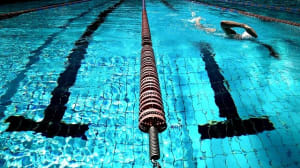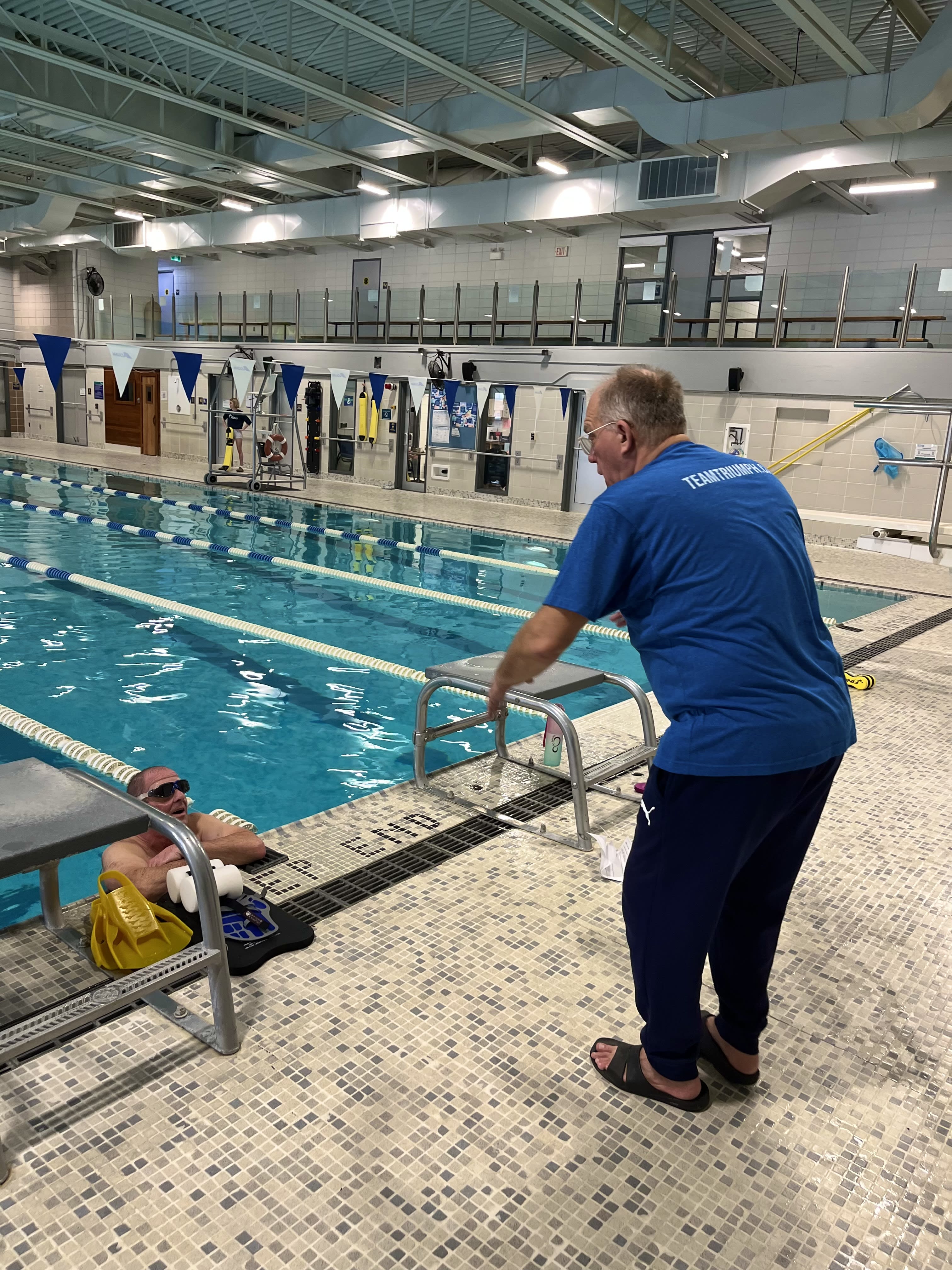
Why Technique trumps Fitness in Swimming
Ever wondered why when you compare your times for a 100 m all-out sprint vs a 100 m at your regular pace you are only able to shave off a few seconds? All that extra effort and so little to show for it! What is holding you back – is it swim fitness, or drag, or an inefficient pull? Let’s look at the math (or you can ignore the math and just read the conclusions)
For a swimmer swimming at a steady speed, the forward thrust force developed by the swimmer is equal to the drag force holding the swimmer back.
The thrust you can generate is dependent on your stroke rate and stroke efficiency and the drag force is dependent on factors such as frontal area, drag coefficient (combined in a constant c) and your speed (v).
Using these formulae, we can determine how much extra power you need to deploy to reduce your 100 m time from 2:00 min to 1:00 min assuming your technique does not change (let’s say you just increase stroke rate without improving efficiency or reducing drag):
You need to develop 8x more power to go 2x as fast and as Work= Power x time this corresponds to 4x the work. A lot of training would be required to increase your swimming FTP by 8x!. The bottom line is that you won’t see big speed gains if you just focus on swim fitness.
But what if you could cut your drag in half by say........ not crossing over, swimming more horizontally and eliminating the scissor kick. How much faster could you swim for the same power output (swim fitness level)?
Halving your drag increases your speed by 26% for no extra effort - free speed just like on the bike! Reducing drag can bring significant speed gains independent of swim fitness.
Now, what if you could increase the efficiency of your pull, by working on your catch and increasing the effective length of your pull and this resulted in 2x the F(thrust)? How much faster (v2) would you go if the drag stayed the same?
Doubling the forward propulsion from your pull increases your speed by 41%! Note that the speed does not double because drag increases exponentially with speed. The power required also has to increase, but only by 2.8x and some of this could come from efficiency gains rather than fitness gains. Let us now assume you had a really awesome coach and they were able to take you, a 2:00 min/100 m swimmer, and both halve your effective drag and double your forward thrust by improving your technique. How fast would you go?
This is twice as fast, i.e. 1:00 min/100 m! Now of course this speed gain requires more power to achieve (about 4x) but much less than the 8x needed if you did nothing to improve stroke efficiency and reduce drag. Although swim fitness is important, especially for endurance events, technique improvements to optimize catch and pull efficiency and reduce drag will bring bigger gains in performance. Relying solely on swim fitness improvements alone to gain speed is not a winning strategy – take some lessons to improve your technique!
The correct pacing, however, is an important part of a winning strategy. Consider an athlete who starts out fast at 125% of their endurance pace for the first quarter of an IM swim leg, then tires and slows down to 75% for the next 2 quarters. Recovered and anticipating the finish line the swimmer increases the pace to 125% for the remaining quarter. The average pace for the swim leg is 100% of the athlete’s endurance pace. However, it can easily be shown that the average power required is about 1.19x the power required to complete the swim at a constant pace of 100% of endurance pace. This is because power requirements increase exponentially with speed. The power costs of the pace increase at the start and end of the swim leg are not balanced by the power savings resulting from the slower pace over quarters 2 and 3. Indeed, for the same 1.19x higher power output had the swimmer maintained a constant pace that pace would have been 6% faster – saving about 3:30 min from a 1 hr IM swim for example. The fastest way to swim is to hold a constant pace and learning to maintain your maximum endurance pace should be an important part of your training.
Phew....that was a lot of information. Whether you read the full article or jumped to the conclusion, I'm sure your next question is, how can I take this information and implement it into my training to improve my technique? This is where Team Triumph comes in.
We have just launched a NEW program - Mastering the High Elbow Catch (2 session course).
This 2-lesson private course reveals the simple steps you can take to begin to master the elusive high elbow catch. We use an approach unique to Team Triumph that explains why and teaches you how. It involves both real-time visuals using mirrors in the pool and video feedback. This course is recommended for experienced swimmers who are looking to break through to the next level of swim efficiency.
I will be conducting this course. To find out more information about me as a Coach you can visit our website
Let me help you break through to the next level in your swimming. Send an email to info@pbest.ca to book a session.
If you are not ready for this course but are still looking for help with your swimming, we have other options available. We have private swim lessons with video analysis which is different than our new course and without a video analysis.
We also offer Private Coaching for those looking for a more personal coaching experience. You can find this information on our website.
Send us an email to info@pbest.ca to book a session.

Kevin Willis
NCCP Triathlon Adult Community Coach
Team Triumph Triathlon Club

I would highly recommended Eric and Team Triumph!
Ian Ross

A year ago I could only tread water and had not run since childhood. With the amazing Virtual Olympic course, support, guidance, and tips from of all the folks at Team Triumph I've ended the season with my first Olympic distance triathlon under my belt and am hooked! Really looking forward to the 2025 season and even to the hard work over the winter to prepare. Karen Houle

I wanted to let you know that the Perth triathlon was a great experience, I somehow placed third in my age group! What a supportive group of participants (including Team Triumph athletes), cheering bystanders and volunteers.
Thanks to your swim lessons, I learned the technical basics and gained confidence to get back in the pool after decades. And it was really special doing this with Ann Laidlaw, my bestie for many years. We did a couple of additional swims with Kevin and Team Triumph people, also a great way to continue learning and practicing good technical form.
I will continue with lane swimming and who knows, maybe there's another triathlon in my future!